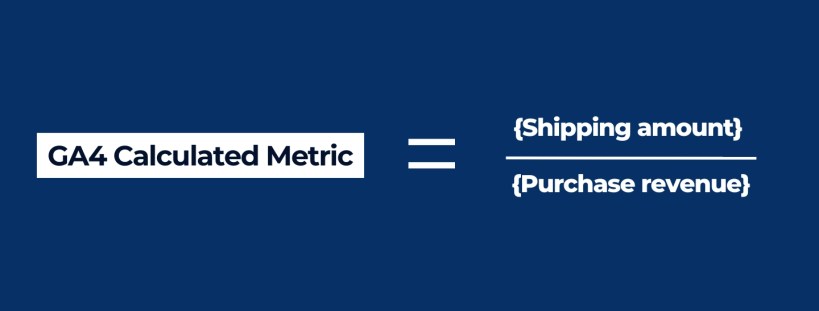
The recent inclusion of computed metrics to GA4’s personalized definitions has further widened the opportunities for data analysis. In this article, we will delve into the notion of GA4 calculated metrics, how to formulate them, and the potential advantages they offer businesses and marketers.
We will also deliberate on the constraints of calculated metrics and deliver real-world application scenarios to demonstrate their use. At the end of this article, you will possess a comprehensive comprehension of calculated metrics in GA4 and how they can enable you to extract valuable insights from your website or application data.
What are computed metrics in Google Analytics 4?
Computed metrics in Google Analytics 4 are personalized definitions that allow you to undertake advanced analysis and acquire deeper insights into your data by blending existing metrics using mathematical formulas.
In brief, computed metrics enable users to derive new insights by merging existing metrics or by joining existing metrics with a constant value using mathematical formulas. To create a computed metric, Google Analytics 4 allows you to select the metrics you wish to utilize and implement mathematical operations such as addition, subtraction, multiplication, or division. This empowers you to craft new metrics that are not available by default in Google Analytics 4.
For example, you can devise a computed metric to compute the Lead Form Submission Rate, by dividing the Form Submissions by the Form Views. The Formula will be something like this – Lead Form Submission Rates = {{Form Submissions}} / {{Form Views}}. “Form Submissions” and “Form Views” should be established as personalized events in Google Analytics 4.
Computed metrics in Google Analytics 4 possess retrospective capability. This enables you to execute calculations and derive insights retrospectively, allowing you to report on historical data using these metrics. Additionally, you can leverage computed metrics in both GA4 standard reports and exploration reports. This flexibility enables you to customize your analytics data and extract valuable insights tailored to your unique business goals.
Although both computed metrics and personalized metrics are user-defined, they are quite distinct from each other. Computed metrics are for deriving new data from the already available data in GA4, while Personalized metrics are for tracking and collecting numerical data that are unavailable by default in GA4.
Advantages of using GA4 computed metrics
There are several advantages of using computed metrics in Google Analytics 4; let’s discuss a few of them below:
- Customization: Computed metrics allow you to create user-defined metrics tailored to your business needs. You can combine existing metrics to create new metrics that provide deeper insights into your data.
- Advanced Analysis: Computed metrics enable more sophisticated analysis by allowing you to perform mathematical operations on your data. You can create complex formulas to calculate ratios, averages, conversion rates, and other metrics unavailable by default in Google Analytics.
- Deeper Insights: By leveraging computed metrics, you can gain deeper insights into your website or app performance. These metrics can help you understand user behavior, engagement levels, conversion rates, and other important metrics specific to your business goals.
- Data Consistency: Computed metrics ensure consistency in your data analysis. Instead of manually calculating metrics outside of Google Analytics, you can create computed metrics within the platform, ensuring that the calculations are accurate and consistent across all your reports.
- Reporting Flexibility: You can use computed metrics in various reports within Google Analytics, including the exploration reports, and personalized reports. This gives you the flexibility to analyze your data in different ways and create personalized reports focusing on the metrics that matter most to your business.
Overall, computed metrics in Google Analytics 4 provide a powerful tool for customizing and analyzing your data. Computed metrics are retrospective, so you can report on historical data with computed metrics, allowing them to work retrospectively. This enables you to gain deeper insights and make data-driven decisions for your business.
How to generate a computed metric in GA4?
To generate a computed metric in Google Analytics 4, follow these steps:
- In the left-hand menu, click “Admin” to access the Admin settings.
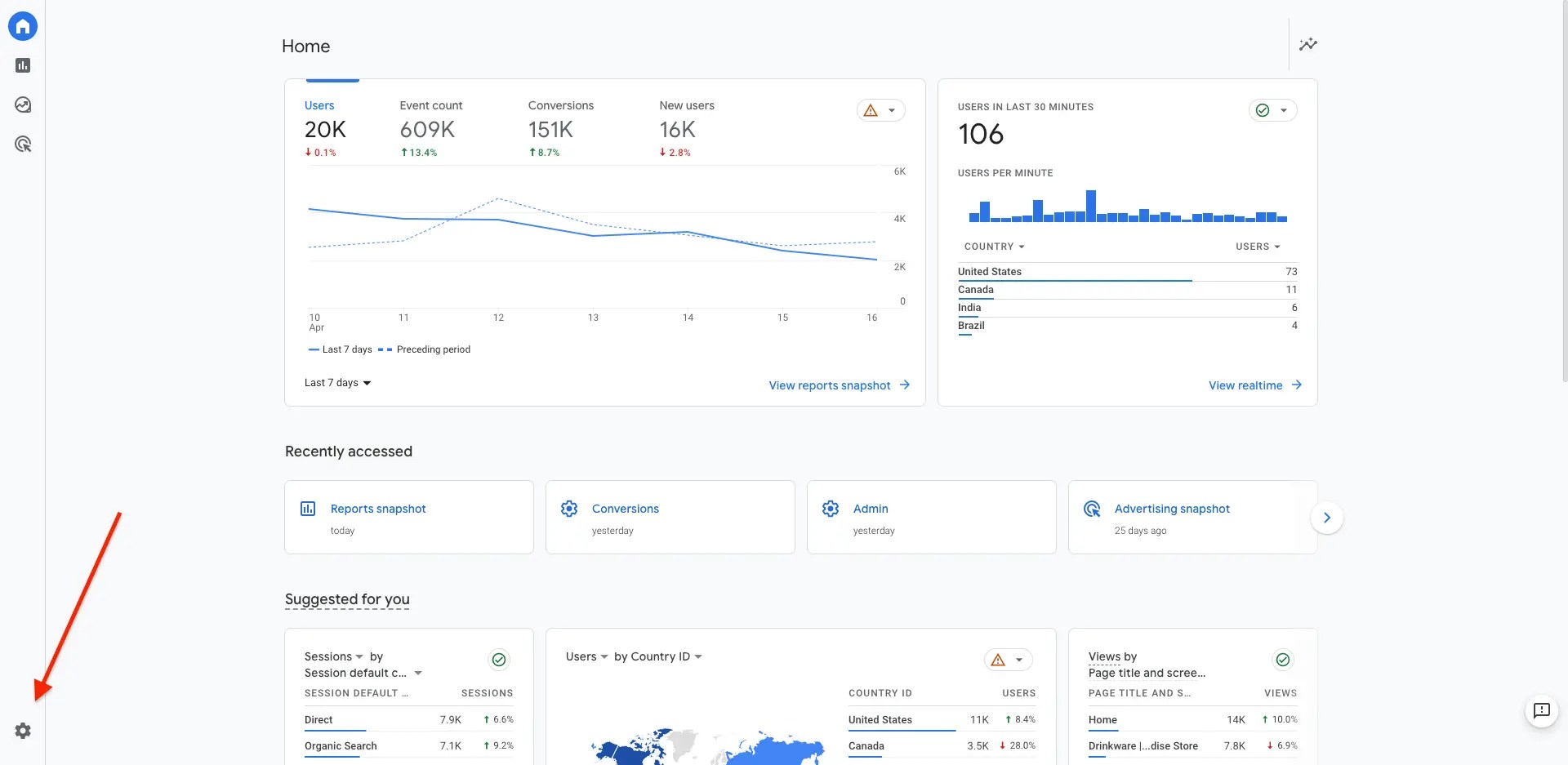
- Under the “Data Display” settings, click on “Personalized Definitions.”

- Click on the “Computed Metric” and then tap the “Formulate computed metric” button, which opens the formula builder.<p
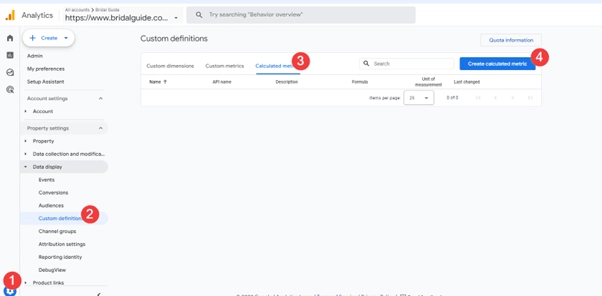
- Employ the formula constructor to devise your preferred calculation.
You are capable of choosing pre-existing metrics and applying arithmetic operations such as addition (+), subtraction (-), multiplication (*), and division (/). Construct a descriptive title for your metric; GA4 automatically fills in the API. In the description field, craft a phrase that outlines the metrics. Employ the formula field to inscribe your equation, then designate the unit of measurement for your metric.
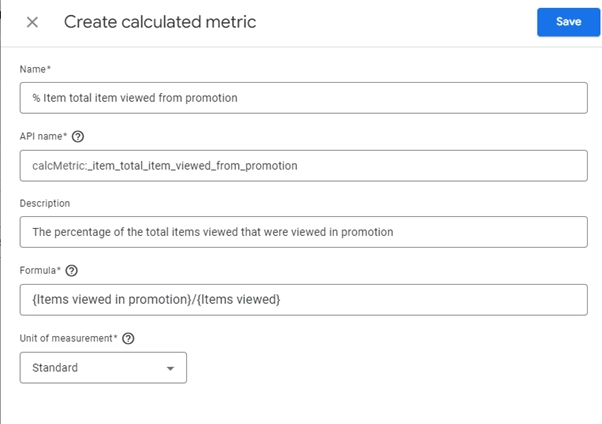
In our illustration, we established a metric that computes the proportion of the total viewed items that users observed in a promotion. Store the calculated metric, and it will be accessible in your reports.
How to use freshly formulated metrics in GA4 reports
You are capable of applying the freshly formulated metrics in GA4 accepted reports and exploration reports.
To utilize a new metric in Google Analytics 4 accepted reports, adhere to these directions:
1. Approach the reporting section in your GA4 account by selecting “Reports” in the left-hand menu.
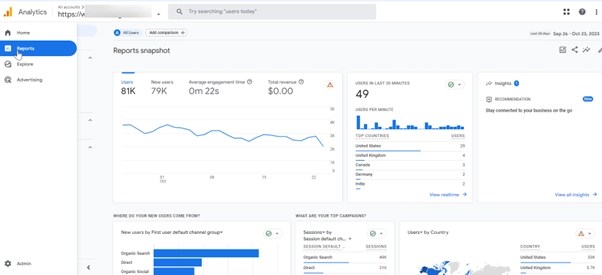
2. Pick the report you wish to operate with, like the Acquisition report, and press the customize report button.

3. Seek the “Metrics” section, choose the “Add Metrics” drop-down button. Scroll down to locate your freshly created metric.
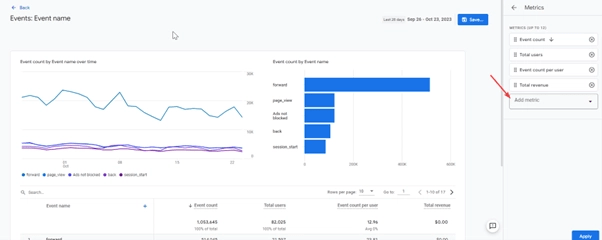
4. Upon selection, the calculated metric will be included in your report, allowing you to analyze your data using this metric.
To employ the freshly created formulated metrics in an exploration report. Just proceed to explore, select a blank report, and click on the plus (+) sign beside the metrics to append the formulated metrics you created under custom, import them, then integrate them into your report.
GA4 formulated metrics constraints
Calculated metrics in GA4 encompass particular constraints that are crucial to contemplate. Primarily, in terms of usage, a standard property allows for generating up to 5 calculated metrics, whereas a 360 property allows for producing up to 50 calculated metrics. As such, you must prioritize the metrics you formulate in a standard property. Nonetheless, while GA4 standard property (free accounts) has a constraint of 5 calculated metrics, users can formulate an unrestricted number of calculated metrics in Google Looker Studio once they connect the property to Google Looker Studio.
The level of detail in the underlying data also plays a role in the precision of calculated metrics. Depending on the granularity of the data, the accuracy and specificity of the calculated metrics may vary.
Furthermore, it’s important to note that referencing a calculated metric within the formula for another calculated metric is not possible. Instead, only predefined and custom metrics can be used when constructing the formula for a calculated metric, limiting their ability to build upon each other for more complex calculations.
Comprehending these constraints helps guarantee appropriate utilization and interpretation of calculated metrics in Google Analytics 4.
GA4 versus UA calculated metrics
There are some disparities between calculated metrics in Google Analytics 4 (GA4) and Universal Analytics (UA); some of them include:
- Data Model: GA4 utilizes an event-based data model, while UA employed a session-based one. This impacts how calculated metrics are defined and calculated in each platform.
- Formula Constructor: GA4 introduced a new formula constructor for creating calculated metrics, presenting a more user-friendly interface than UA’s formula editor.
- Metric Dependencies: In GA4, calculated metrics cannot reference other calculated metrics. However, in UA, calculated metrics could reference other calculated metrics, allowing for more complex calculations.
- Reporting Availability: GA4 calculated metrics are applicable in reports, exploration reports, and GA Data API. In UA, calculated metrics could be employed in custom reports and some pre-built reports, but not all reports support them.
Do you require assistance with configuring calculated metrics?
To leverage the complete potential of calculated metrics and unlock actionable insights for your enterprise, mull over partnering with our professional GA4 analytics service. Our team of specialists can support you in navigating the intricacies of calculated metrics, optimizing their utilization, and deriving meaningful insights tailored to your specific business objectives. Reach out to us today and let us aid you in maximizing the potential of your GA4 data.
Final Word
In conclusion, in GA4, calculated metrics are metrics that users can create by combining existing metrics through mathematical formulas or by combining existing metrics with a constant value using mathematical formulas. These metrics allow for more advanced analysis and deeper insights into your data. One key feature of calculated metrics in GA4 is their retrospective nature, meaning they can collect and report on historical data. This enables you to apply calculations and derive insights retrospectively, even if you create the calculated metric after the data is collected. By leveraging calculated metrics in GA4, you can create metrics tailored to your needs, comprehensively understand your data and make informed decisions based on historical trends and patterns. Overall, calculated metrics in GA4 offer a valuable way to gain deeper insights and conduct advanced analysis of your data. While it’s essential to be mindful of their limitations, such as data granularity and the inability to reference other calculated metrics, these metrics can still provide valuable insights when used effectively.
About us and this blog
We are a digital marketing company with a focus on helping our customers achieve great results across several key areas.
Request a free quote
We offer professional SEO services that help websites increase their organic search score drastically in order to compete for the highest rankings even when it comes to highly competitive keywords.
Subscribe to our newsletter!
More from our blog
See all postsRecent Posts
- Exhaustive Manual on Initial Pageviews in Google Analytics 4 February 7, 2024
- GA4 Conversions Monitoring | Exhaustive Manual January 31, 2024
- A Comprehensive Tutorial on Monitoring File Downloads in GA4 January 24, 2024










Pingback: voltaren cream generic
Pingback: sitagliptin renal function
Pingback: can spironolactone cause constipation
Pingback: venlafaxine and marijuana
Pingback: synthroid pronunciation
Pingback: how much is ivermectin
Pingback: tizanidine 2mg tablets
Pingback: tamsulosin bluthochdruck
Pingback: actos guidelines
Pingback: robaxin contraindications
Pingback: protonix price
Pingback: remeron dosage for sleep
Pingback: abilify for kids
Pingback: acarbose origine
Pingback: repaglinide absorption
Pingback: celecoxib warnings
Pingback: side effects of bupropion
Pingback: what does celexa treat
Pingback: how long does augmentin take to work
Pingback: buspar 5mg
Pingback: best time to take ashwagandha
Pingback: aspirin structure
Pingback: allopurinol 300mg tablet
Pingback: can you overdose on amitriptyline
Pingback: aripiprazole 2mg tablets
Pingback: cozaar generic name
Pingback: augmentin dose for sinus infection
Pingback: contrave 8 mg-90 mg
Pingback: interaction between flomax and cialis
Pingback: citalopram and marijuana
Pingback: severe hepatic side effects of ezetimibe
Pingback: medications depakote
Pingback: stability of ddavp for iv
Pingback: is flexeril addictive
Pingback: how long for effexor to work
Pingback: diltiazem drug interactions
Pingback: diclofenac gel side effects
Pingback: neurontin and pregnancy
Pingback: human amoxicillin for dogs dosage chart
Pingback: will i die if i drink on bactrim
Pingback: bactrim dosage 800/160 for uti
Pingback: prednisone and cephalexin
Pingback: ciprofloxacin.3 eye drop
Pingback: can humans take dog cephalexin
Pingback: when does cymbalta start working
Pingback: lexapro withdrawal
Pingback: where to buy otc sildenafil
Pingback: duloxetine generic price
Pingback: • escitalopram
Pingback: co-gabapentin wiki
Pingback: fluoxetine color
Pingback: how long does it take for zoloft to kick in
Pingback: metronidazole thirst
Pingback: does keflex treat strep throat